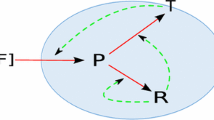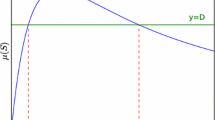Abstract
A simplified one-dimensional growth model based on the mass conservation law is proposed. Mathematically, it represents an easiest special case of so called L-systems. The model developed being considered as a descriptive tool of the growth curves is compared with four other similar and widely used models, in application to numerical data of bacteria (taken from literature) and of algae (an original experiment) growing in batch. Identification of free constants of the five models in comparison is performed using a nonlinear least squares iterative procedure, for which special programs were written. Theoretical and practical (approximative) merits of the new model are shown and discussed.
Similar content being viewed by others
References
Blackman, F. F.: Optima and limiting factors. Ann. Bot., 19, 281–295 (1905)
McKendrick, A. G., Poi, M. K.: The rate of multiplication of microorganisms: a mathematical study. Proc. R. Soc. Edinb., 31, 649–661 (1910)
Blackman, V. H.: The compound interest law and plant growth. Ann. Bot. 33, 353–360 (1919)
Robertson, T. B.: The chemical basis of growth and senescence. Philadelphia, London: Lippencott (1923)
Lotka, A. J.: Elements of Physical Biology. Baltimore: Williams and Wilkins (1925)
Peal, R.: Introduction to medical biometry and statistics. Philadelphia: Saunders 1940
Feller, W.: On the logistic law of growth and its empirical verifications in biology. Acta Biotheor. 5, 51–65 (1940)
Monod, J.: Recherches sur la croissance bacterienne. Paris: Hermann 1942
Richards, F. J.: A flexible growth function for empirical use. J. Exp. Bot. 10, 290–300 (1959)
Lyapunov, A. A.: On cybernetic problems of biology. (Russian) Prob. Kibern. 25, 5–39 (1972)
Dabes, J. N., Finn, R. K., Wilke, C. R.: Equations of substrate-limited growth. The case of Blackman kinetics. Biotechnol. Bioeng. 15, 1159–1177 (1973)
Poletaev, I. A.: Volterra's predator-prey models and some of their generalizations using Liebig's “bottle-neck principle” (Russian). Zhurnal Obsticheij Biologii 34, 43–57 (1974)
Poletaev, I. A.: Some mathematical models of population, with regard to the environmental influences (Russian). Zhurnal Obshcheij Biologii 40, 915–925 (1979)
Ginzburg, M., Ginzburg, B. Z.: Interrelationships of light, temperature, sodium chloride and carbon source in growth of halotolerant and halophilic strains of Dunaliella. Br. Phycol J. 16, 313–324 1981
Causton, D. R., Venus, J. C.: The biometry of plant growth. London: Arnold 1981
Ginzburg, B. Z., Ginzburg, M.: Studies on the comparative physiology of the genus Dunaliella (Chlorophyta, Volvocales). 1. Response of growth to NaCl concentration. Br. Phycol J. 20, 277–283 (1985)
Author information
Authors and Affiliations
Rights and permissions
About this article
Cite this article
Kolker, Y. A piecewise-linear growth model: comparison with competing forms in batch culture. J. Math. Biology 25, 543–551 (1987). https://doi.org/10.1007/BF00276198
Received:
Revised:
Issue Date:
DOI: https://doi.org/10.1007/BF00276198




